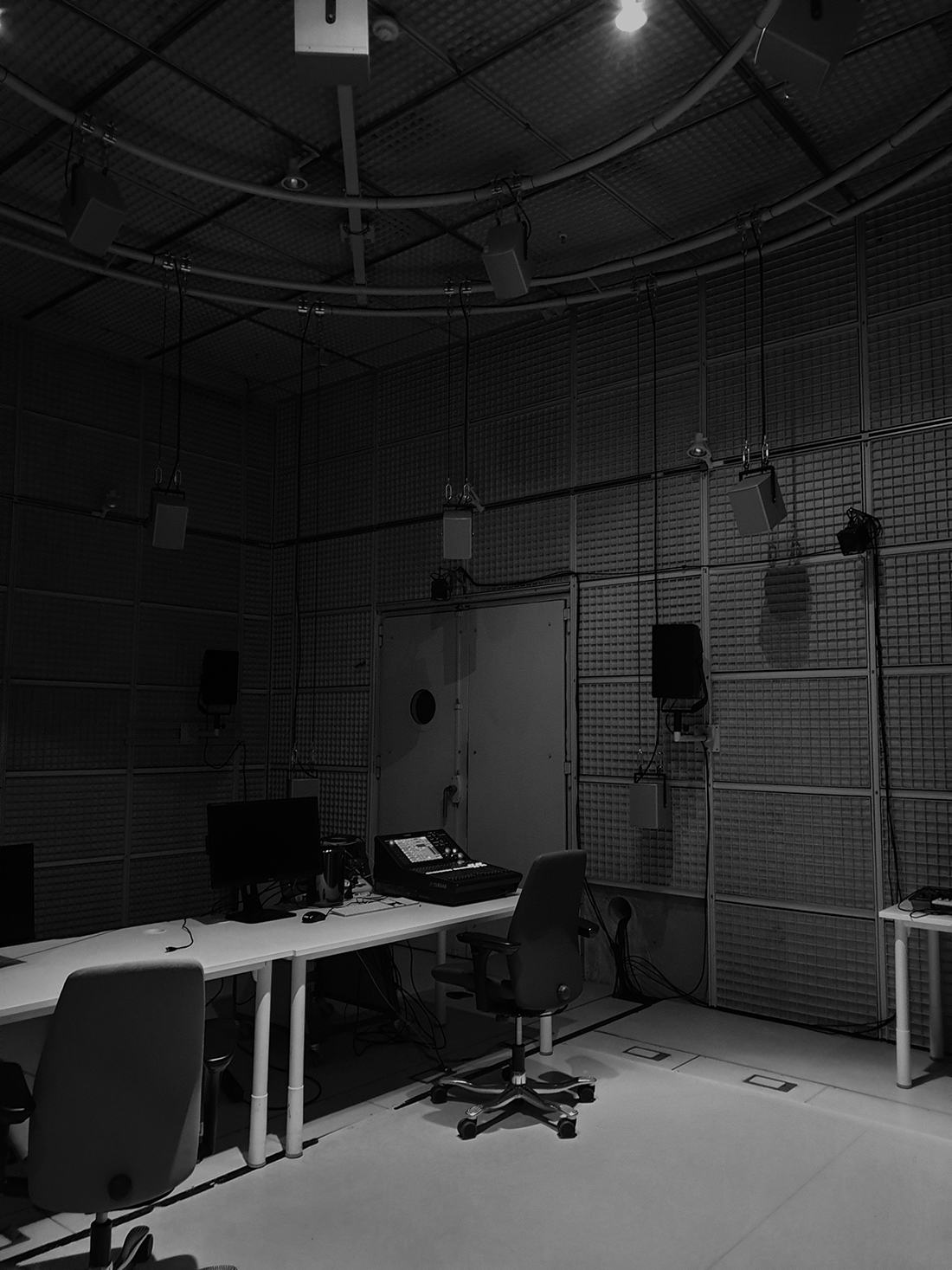
ircam studio 1 in feb 2020
06-10_2020
+++++++++++++++++++++++++++++++++++++++++++++++++++
70 minutes Ircam commission premiered at the Centre Pompidou’s Grande Salle in September 11th, 12th and 13th 2020. The piece was to be played at T2G and other places. The piece is part of a series of four sound fictions (~ Hörspiel) using an ambisonic system diffusion. This one is taken from Céline Minard‘s Bacchantes.
Céline Minard brilliantly revisits the codes of the robbery film around the theme of wine to distill an explosive cocktail where drunkenness mingles with subversion. Jackie Thran’s brigade has surrounded the most secure wine cellar in Hong Kong for fifty-nine hours, housed in former British army bunkers. A group of criminals has managed to break into it and keep the impressive stock stored there hostage. Suddenly, the armored door of the Alpha bunker opens. A gloved hand appears, places a bottle on the ground. A foot wearing a black pump comes out of the gap and pushes the glass body onto the floor. Steel slaps again…
The action, because there is action, also extends around this wine cellar. Seven characters are there. They communicate directly or through loudspeakers. The tension is only rising; precious bottles are being emptied.
A narrator describes the circumstances. They spin out of control until everything becomes unrealistic as a typhoon approaches. The situation, the space and time around it, becomes unreal, perhaps surreal. The characters, losing control, finally become animated by a music emerging from the dramaturgical stratagem. It has undoubtedly taken them by surprise as much as time moves forward as if the two were one.
Personalities nevertheless remain inked, indelible and immersed in the accumulation of this entirely synthetic simulation.
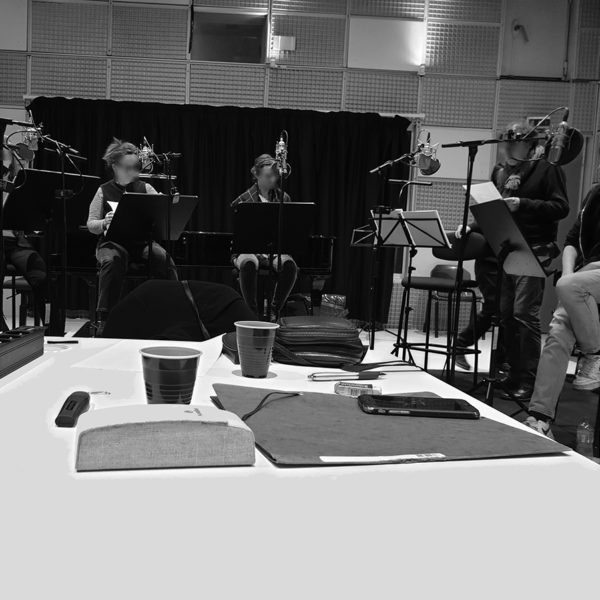
recording sessions in studio 5
with voices of:
bénédicte wenders
geoffrey carey
julien cussonneau
isabelle mazin
malvina plégat
sabine moindrot
text: céline minard (payot-rivages edition, 2019)
adaptation: thierry bédard
sound egnineer & mastering: jérémie bourgogne
light design: claudio cavallari & lenaic pujol and juliette besançon
musical composition: olivier pasquet
special thanks to benoit piccand for his down-mix into binaural and stereo for the radio-phonic version.
special thanks to endo takamitsu for his inspiring programming work
7-order ambisonic (64 speakers) _ grande salle centre pompidou
The following short extracts do not include voices. I will present them, including how I implemented them, in the near future. I however project to make a purely musical album in the short term:
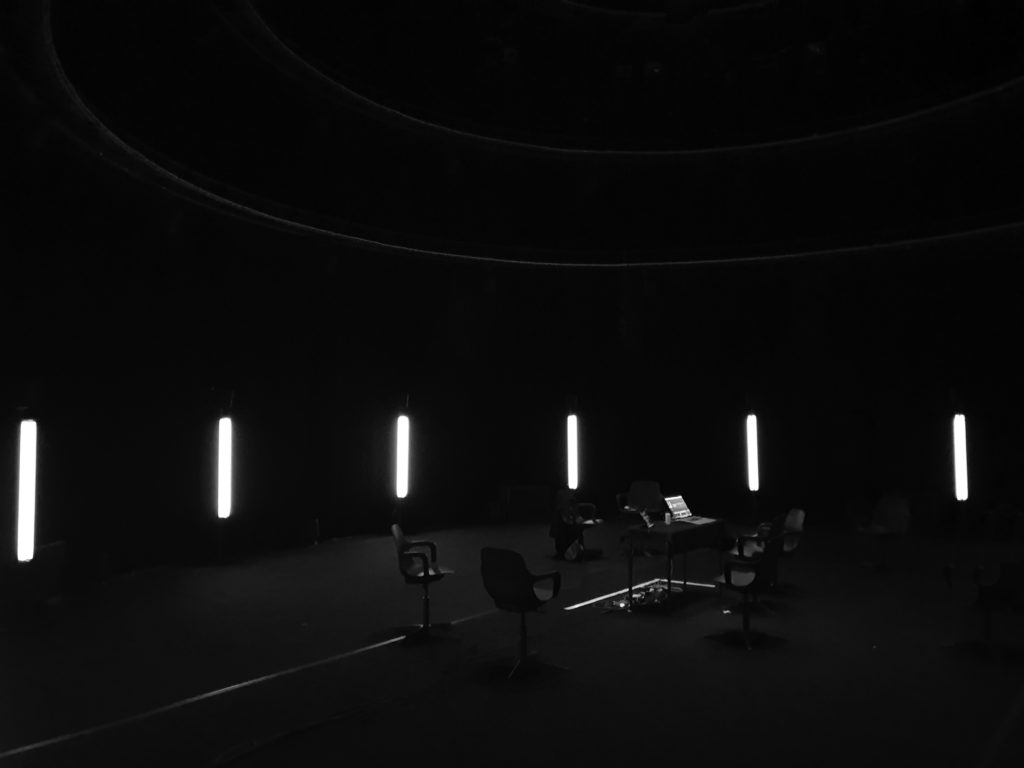
bacchantes tests at t2g gennevilliers, france _nov 2020
I wanted to share a small part of the artistic research that I have oriented myself towards for this fictional music. This probably allows me to fill this small lack of time to discuss it in person.
I admit that this format of recorded and spatialized voices finally offered me an opportunity to go beyond an utilitarian music that would be purely at the service of narration (from the consumerist aspect of it). So I oriented my work towards experimentation, not just production. I almost always relate these two perspectives as if to confront the “technical” work with its inseparable social part.
I have chosen to ensure that the three relationships between narration, voices and music become one and interact horizontally. Each element is supposed to find its place naturally without being at the service of another. It is a game of continuous change of focus without being traditional musical theatre and while remaining within the concept of fictional music. The play could easily have diverged towards a form of radio musical theatre if I had gone further in the work of the voices for example.
The impression of a permanent invasion was my initial intention given the hysteria and intensity of the scenes. At the same time, there is an underlying construction that is purely musical and simple enough to offer the listener the possibility of this focus. I intentionally avoid focusing the listener’s concentration by playing with various musical scales and spatial positions.
The use of ambisonic is right in this case. It allows to move the ear in the course of the work between a global listening in the center, a listening more oriented towards the musical part with the back to the actors’ voices or, finally, a listening more oriented towards the actors’ playing. This is only possible because the text and its story are relatively simple.
So I forced myself to use notorious connotations such as continuous sounds, pedals. I thus avoided forcing any kind of primary tone or beauty; dramaturgic or musical. You could say that I was violent from a romantic point of view and that this is also my style. From this deprivation, however, there remains an aesthetic that is strong enough not to be pure ornament. It is rather the starting point for something musical.
The sounds, all synthetic, unreal, fictional and sanitized, are black and white. I programmed completely unreal ambisonic spaces from a patchwork of codes from reverberations, physical models. But above all I take a minimalist path composed of millions of particles, of infinitesimal sounds (sometimes at the limit of the click) rhythmically composed. From these skeletal structures emerge this post-modernist form that happily, and joyfully, sticks with this text that incites maximalism. It is also the choice to make “scholarly” electronic music.
I am therefore looking for relationships between text and sound that are more akin to reading, or even deciphering, infinitesimal sound forms, letters and words.
However, the play has distinct offbeat elements that would have been even more absurd in the case of a material play. Some are consciously placed according to the text. But others arrive almost accidentally by algorithmic dosing according to the text. These unchosen decisions allow me to sharpen the line between the “nicely placed” and the “shifted”; the right balance between a Pollock-like automatism and the machinal. That’s how I am algorithmically managing various relationships to kitsch, and to pop with post-modernist theatre director’s work Guillaume Vincent for example.
This conception means that the text goes out if the music disappears. Above all, the opposite makes the situation even more difficult; when the music stops, it is the buttress of the whole environment that disappears and with it dramaturgy. By forcing myself to think and program in this way, I force myself to avoid a neo-classical form. Nevertheless, you will notice that the play has an overture, a semblance of ABA and other humorous expected elements such as a long silence after the word “silence” has been uttered.
The question of form is obviously a recurring research question for me; classic for anyone who tries… I often seek to link and generalize the various scales of composition in order to achieve an intrinsic transcendence that transforms the piece into a series of expressive architectural objects… This is how I build myself artistically with the reciprocity brought to me by my generative music tools.
My musical pieces for theater, dance, but especially my installations create complex time relationships and above all non-linear listening. I often explore these singular, sometimes accidental coherence, by algorithm, in purely sonic music with the hope of digging elsewhere than in other musicians.
I must also admit that I have found no other pragmatic choice with 6 actors, 1 narrator and a story that lasts an hour and ten minutes end to end. I don’t know how I would have got through it if the text hadn’t been burlesque and excessive. It’s so well done that I wonder in which direction the confrontation took place. To what extent Thierry’s casting and the text were perfectly chosen for me. Or, as is often the case outside of my pure electronic music, to what extent I integrated the necessities of this fiction with my usual formal work. The experience and the pleasure make me think that both were simply there.
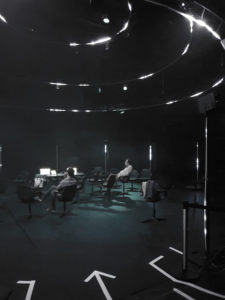
bacchantes rehearsals with led lighting at centre pompidou in sept 2020 during covid times.
Interview by musicologist Jérémie Szpirglas (available in French down the page):
A book is normally written to be read for oneself, in one’s head: how did you approach the challenge of making it sound?
I’ve been composing purely electronic music for years; would it be a social backlash? I’m very passionate about pieces that are not performed by an instrumentalist and that reach the listener as directly as possible. There are unfathomable questions of causality in the chain of transmission of information. For example, what to do with a generative piece with no beginning or end, with an infinity of possible or parallel versions? Should we do something with it? Should it be played in museums in the afternoon, in concert halls at night, in nightclubs at night, or finally with headphones on?
Anything related to a linear chronological reading is therefore part of my explorations, especially if it can be done internally. There is nothing more captivating than deciphering shapes across various scales. The type of active concentration for this music can also very well take the form of narration. It is through this taking of form that the sensible is created by transforming formalization into affect. This is where the music, the actors’ acting and the text collide.
In this case, there is no visual support, but there is the ambisonic device: how to seize this immersive technological tool in this framework?
Ambisonie allows you to recreate sound spaces artificially with the help of a sphere of loudspeakers. This allows me to approach the text through a fictional universe; an artificial world in which the scenes take place. Everything that happens in this container, this immersive device, is only representation and simulation.
What the voices represent is paramount without visual support. Their strength is multiplied when they belong to a realistic space. The dramaturgy becomes concrete when this space is taken into account; when it comes into play. A synthetic, possibly unreal space is therefore no longer just a container but an integral part of the content.
Ambisony thus makes it possible to create scientifically incoherent spaces, and to compose them with sound, time and the multitude of other dimensions that create the object of the work. As with sound, I create the sound spaces, the intangible traces of the action, by accumulating a multitude of infinitesimal and primitive elements; voxels, three-dimensional pixels.
In this way, I transport the listener into a kind of cartoon whose contours underline the ubuesque and burlesque situation of the text. The play might have a hint of cyberpunk.
How can we approach this new format, which is also akin to cinema (a fixed medium, which we understand collectively), installation and radio play? Especially for a book like this one, which is a bit like a thriller…
The piece will initially be presented as a form of performative installation. The temporal linearity of the story imposes a beginning and an end.
The device does not force the audience to move around in the sound sphere. The absence of a screen, the relative proximity of the loudspeakers and the fact that it is possible to create artificial spaces in a dead room, allows the listeners to physically explore the virtual spaces. They do this by moving around, turning their head or simply reaching for an ear in one direction.
This piece could be “augmented radio” thanks to the music, the device and the social context in which it is presented. It is also “augmented cinema” as it would have been if we had all been blind. But it is above all an object, an almost sculptural materialization of a text, of a story told. It differs from a physical object in that it is easily reproducible.
What kind of collaboration did you have with the rest of the team, and especially with the director? What is the articulation between spoken text and music?
The text takes us inside and outside a luxury wine cellar in Hong Kong. In my opinion, the city is perfect for contrasting the intimate moments of other louder ones. Three people find themselves at the centre. Recluded in this cellar, they are surrounded by the police. Thierry Bedard chose, then directed the actors. He also allowed me to understand the underlying aspects of the work beyond the anecdote.
The actors’ acting determines the way in which one enters the burlesque character of the story. It obviously has a direct impact on the tone and therefore the aesthetics of the play. The actors and Thierry Bedard dose the tones and prosodies of each intervention in order to keep a coherence of the various colours of the work despite the absence of body. Unlike theatre, the actors’ bodies do not exist for this format of recorded work. Only their voices are tangible. The actors were therefore simply installed in a circle while waiting for their reply. This creates an alternating acting situation which then becomes even more unreal. The actors, both present and absent, find themselves between the real, their reality and the fictional. They have the impression of projecting themselves into an abstract and unknown form. As in the musical part, the actors find themselves intertwined with everything else; in the middle of a beautiful mess.
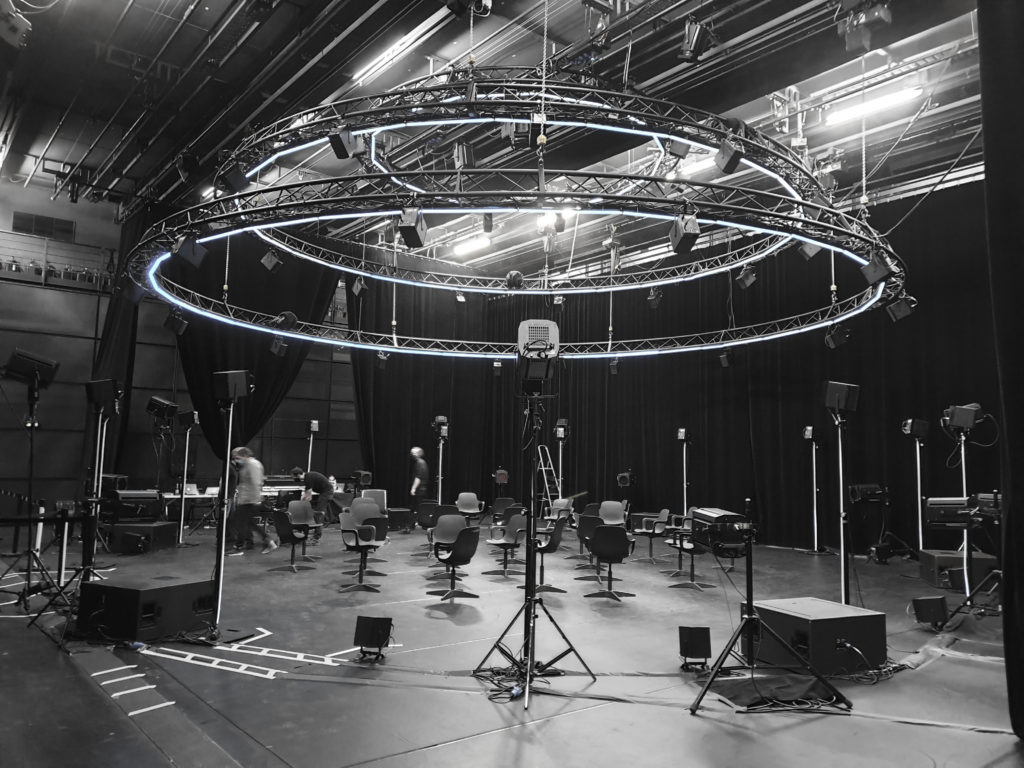
bacchantes setup with led lighting at centre pompidou’s grande salle in sept 2020; light design by claudio cavallari and lenaic pujol.
Introduction text and interview in French:
Bacchantes de Céline Minard se déroule dans un bunker, une cave à vin hongkongaise. L’action, car il y a de l’action, s’étend aussi autour de cette cave à vin. Sept personnages sont là. Il communiquent directement ou par haut-parleurs interposés. La tension ne fait que monter; les précieuses bouteilles se vident.
Un narrateur décrit les circonstances. Celles-ci partent en vrille jusqu’à ce que tout devienne irréaliste au fur et à mesure qu’un typhon approche. La situation, l’espace et le temps qui l’entourent, deviennent tout à tour irréels; peut-être surréels. Les personnages en perdant leur sang froid, deviennent finalement animés par une musique émergente du stratagème dramaturgique. Elle les a indubitablement pris par surprise autant que le temps qui avance comme si les deux ne faisaient qu’un.
Les personnalités restent néanmoins encrées, indélébiles et immergées dans l’accumulation de cette simulation intégralement synthétique.
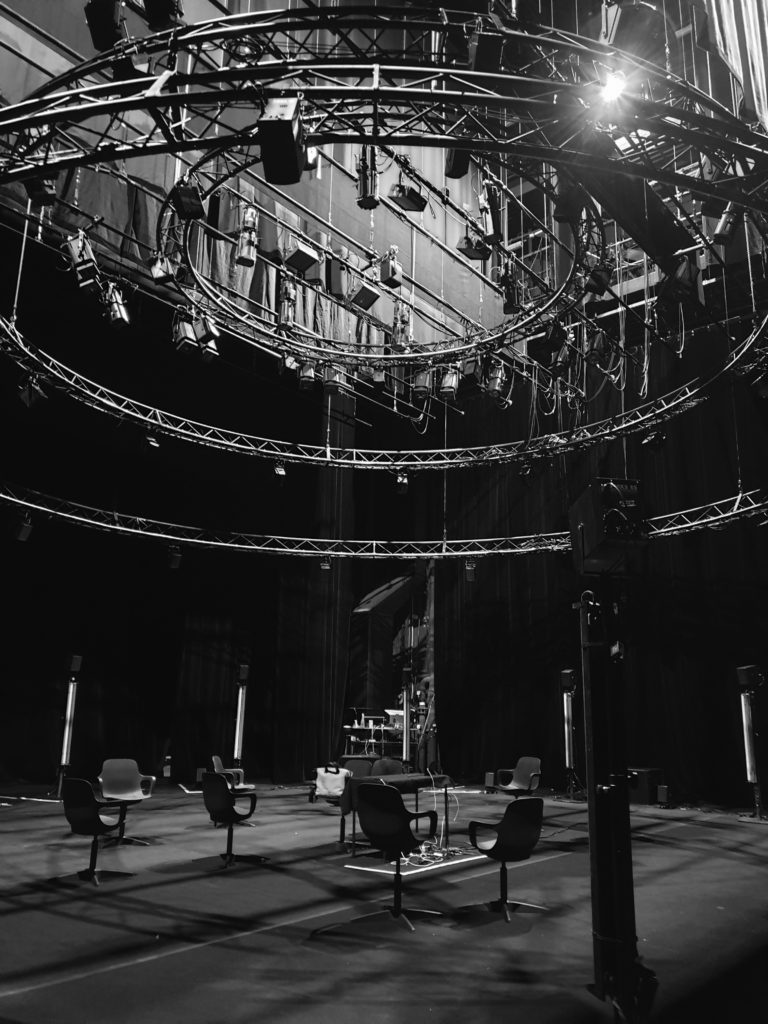
bacchantes setup at t2g gennevilliers, france, in nov 2020; light design by juliette besançon
Un livre est normalement écrit pour être lu pour soi, dans sa tête : comment as-tu abordé le défi de le faire passer au sonore ?
Je ne compose que de la musique purement électronique depuis des années; serait-ce un contre-coup social ? Je me passionne en effet beaucoup aux pièces qui ne sont pas interprétées par un instrumentiste et qui arrivent à l’auditeur le plus directement possible. Il reside en moi d’insondables questions de causalité dans la chaine de transmission de l’information. Par exemple, que faire d’une pièce générative sans début, ni fin, avec une infinité de versions possibles ou parallèles ? Doit-on justement en faire quelque chose ? Doit-on la jouer dans des musées l’après-midi, des salles de concert le soir, des night-clubs la nuit, ou finalement au casque pour soi-même ?
Tout ce qui touche une lecture linéaire chronologique fait donc partie de mes explorations; en particulier si celle-ci peut se faire intérieurement. Il n’y a rien de plus captivant que de déchiffrer des formes aux travers diverses échelles. Le type de concentration active pour cette musique peut aussi très bien prendre la forme d’une narration. C’est par cette prise de forme que le sensible se crée en transformant la formalisation en affect. C’est donc là que se heurtent la musique, le jeu des comédiens et le texte.
En l’occurence, il n’y a pas de support visuel, mais il y a le dispositif ambisonic : comment s’emparer de cet outil technologique immersif dans ce cadre ?
L’ambisonie permet de recréer des espaces sonores artificiellement à l’aide d’une sphère de haut-parleurs. Cela me permet d’approcher le texte au travers un univers fictionel; un monde artificiel dans lequel se déroulent les scènes. Tout ce qui se passe dans ce contenant, ce dispositif immersif, n’est que représentation et simulation.
Ce que représentent les voix est primordial sans support visuel. Leur forces se démultiplient lorsqu’elles appartiennent à un espace réaliste. La dramaturgie se concrétise lorsque cet espace est pris en compte; lorsqu’il entre en jeu. Un espace synthétique, possiblement irréel, n’est donc plus uniquement un contenant mais fait partie intégrante du contenu.
L’ambisonie permet donc de fabriquer des espaces scientifiquement incohérents, et de les composer avec le son, le temps et la multitude d’autres dimensions qui créent l’objet de l’oeuvre. Comme pour le son, je fabrique les espaces sonores, les traces intangibles de l’action, en accumulant une multitude d’éléments infinitésimaux et primitifs; des voxels, pixels tridimensionnels.
C’est ainsi que je transporte l’auditeur dans une sorte de dessin animé dont les contours soulignent la situation ubuesque et burlesque du texte. La pièce pourrait avoir un soupçon de cyberpunk.
Comment approcher, aussi, ce nouveau format qui tient du cinéma (un support fixe, que l’on appréhende collectivement), de l’installation et de la pièce radiophonique ? Surtout pour un livre comme celui-ci, qui tient quand même pas mal du thriller…
La pièce sera initialement présentée comme une forme d’installation performative. La linéarité temporelle de l’histoire impose un début et une fin.
Le dispositif lui ne contraint pas le public de se déplacer dans la sphere sonore. L’absence d’écran, la proximité relative des haut-parleurs et le fait qu’il soit possible de créer des espaces artificiels dans une chambre morte (dead room), permet aux auditeurs d’explorer physiquement les espaces virtuels. Il le font en se déplaçant, en tournant la tête ou simplement tendant une oreille dans une direction.
Cette pièce pourrait être “radiophonique augmentée” grace à la musique, le dispositif et le contexte social dans laquelle elle est présenté. C’est aussi du “cinéma augmenté” tel qu’il aurait été si nous avions étés tous aveugles. Mais c’est avant tout un objet, une matérialisation presque sculpturale, d’un texte, d’une histoire relatée. Il diffère d’un object physique de par le fait qu’il aisément reproductible.
Quel type de collaboration as-tu engagé avec le reste de l’équipe, et notamment avec le réalisateur ? Quelle articulation entre texte dit et musique ?
Le texte nous emmène à l’intérieur et à l’extérieur d’une cave à vin de luxe à Hong-Kong. Selon moi, la ville est parfaite pour contraster les moments intimistes d’autres plus bruyants. Trois personnes se retrouvent centrales. Recluses dans cette cave, elles sont entourées par la police. Thierry Bedard a choisi, puis dirigé les comédiens. Il m’a aussi permis d’apprehender les aspects sous-jacents de l’oeuvre au delà l’anecdote.
Le jeu des comédiens détermine la manière dont on entre dans le caractère burlesque de l’histoire. Il a évidemment une incidence directe sur le ton et donc l’esthétique de la pièce. Les comédiens et Thierry Bedard dosent les tons et les prosodies de chaque intervention afin de garder une cohérence des diverses couleurs de l’oeuvre malgré l’absence de corps. A l’inverse du théâtre, le corps des acteurs n’existe pas pour ce format d’oeuvre enregistrée. Seules leurs voix sont tangibles. Les comédiens étaient donc simplement installés en cercle en attendant leur réplique. Cela créé une situation jeu alterné qui devient alors encore plus irréel. Les comédiens, à la fois présents et absents, se retrouvent entre le réel, leur réalité et le fictif. Ils ont l’impression de se projeter dans une forme abstraite et inconnue. Comme pour la partie musicale, les comédiens se retrouvent entrelacés avec tout le reste; au milieu d’un beau bazar.
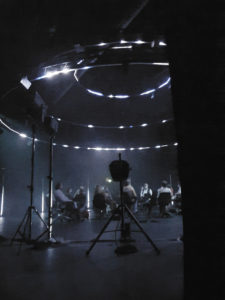
bacchantes performance at centre pompidou during covid-19 _sept 2020
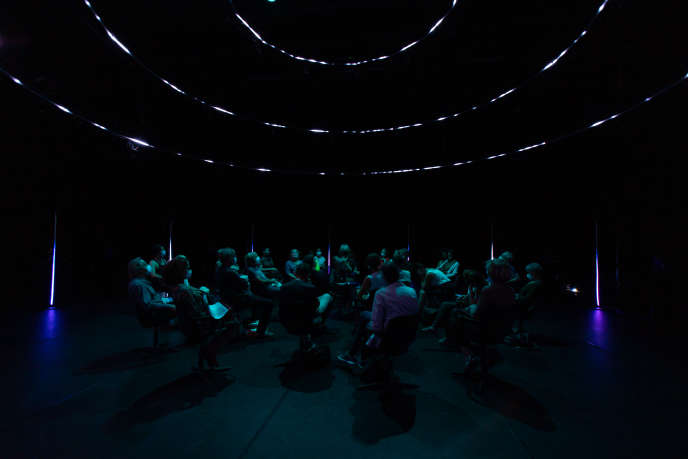
bacchantes performance at centre pompidou during covid-19 _sept 2020
Ich wollte einen kleinen Teil der künstlerischen Forschung teilen, an der ich mich für diese fiktionale Musik orientiert habe. Das erlaubt mir wahrscheinlich, diesen kleinen Zeitmangel auszufüllen, um es persönlich zu besprechen.
Ich gebe zu, dass dieses Format aufgenommener und verräumlichter Stimmen mir endlich die seltene Gelegenheit bot, über eine utilitaristische Musik hinauszugehen, die rein im Dienste der Erzählung steht. Deshalb habe ich meine Arbeit auf das Experiment und nicht nur auf die Produktion ausgerichtet. Ich beziehe diese beiden Perspektiven fast immer so, als wolle ich die “technische” Arbeit mit ihrem untrennbaren sozialen Teil konfrontieren.
Ich habe mich dafür entschieden, dafür zu sorgen, dass die drei Beziehungen zwischen Erzählung, Stimmen und Musik eins werden und horizontal interagieren. Jedes Element soll seinen Platz auf natürliche Weise finden, ohne in den Dienst eines anderen zu treten. Es handelt sich um ein Spiel des ständigen Wechsels des Schwerpunkts, ohne traditionelles Musiktheater zu sein und innerhalb des Konzepts der fiktiven Musik zu bleiben. Das Stück hätte leicht in Richtung einer Form von Radiomusiktheater divergieren können, wenn ich zum Beispiel in der Arbeit der Stimmen weiter gegangen wäre.
Der Eindruck einer permanenten Invasion war angesichts der Hysterie und Intensität der Szenen meine anfängliche Absicht. Gleichzeitig gibt es eine Grundkonstruktion, die rein musikalisch und einfach genug ist, um dem Zuhörer die Möglichkeit dieser Fokussierung zu bieten. Ich vermeide absichtlich, die Konzentration des Zuhörers zu fokussieren, indem ich mit verschiedenen Tonleitern und räumlichen Positionen spiele.
Die Verwendung von Ambisonic ist in diesem Fall richtig. Sie erlaubt es, das Ohr im Laufe der Arbeit zwischen einem globalen Zuhören in der Mitte, einem mehr auf den musikalischen Teil ausgerichteten Zuhören mit dem Rücken zu den Stimmen der Schauspieler oder schließlich einem mehr auf das Spiel der Schauspieler ausgerichteten Zuhören zu bewegen. Dies ist nur möglich, weil der Text und seine Geschichte relativ einfach sind.
Also zwang ich mich, berüchtigte Konnotationen wie Dauerklänge, Pedale zu verwenden. So habe ich es vermieden, irgendeine Art von Primärton oder Schönheit zu erzwingen; dramaturgisch oder musikalisch. Man könnte sagen, dass ich aus romantischer Sicht gewalttätig war und dass dies auch mein Stil ist. Von dieser Entbehrung bleibt jedoch eine Ästhetik, die stark genug ist, um kein reines Ornament zu sein. Sie ist vielmehr der Ausgangspunkt für etwas Musikalisches.
Die Töne, alle synthetisch, unwirklich, fiktiv und hygienisch, sind schwarz-weiß. Ich programmierte völlig unwirkliche ambisonische Räume aus einem Patchwork von Codes aus Nachhall, physikalischen Modellen. Vor allem aber gehe ich einen minimalistischen Weg, der aus Millionen von Partikeln besteht, aus infinitesimalen Klängen (manchmal an der Grenze des Klicks), die rhythmisch komponiert sind. Aus diesen Skelettstrukturen entsteht diese postmodernistische Form, die fröhlich und freudig an diesem Text festhält, der zum Maximalismus aufruft. Es ist auch die Wahl, “gelehrte” elektronische Musik zu machen.
Ich suche daher nach Beziehungen zwischen Text und Klang, die eher dem Lesen oder gar dem Entziffern von infinitesimalen Klangformen, Buchstaben und Wörtern ähneln.
Das Stück weist jedoch ausgeprägte ausgefallene Elemente auf, die im Falle eines Materialspiels noch absurder gewesen wären. Einige sind bewusst dem Text entsprechend platziert. Aber andere gelangen fast zufällig durch algorithmische Dosierung gemäß dem Text. Diese ungewählten Entscheidungen erlauben es mir, die Linie zwischen dem “Schönen” und dem “Verschobenen” zu schärfen; die richtige Balance zwischen einem Pollock-artigen Automatismus und dem Maschinalen. So verwalte ich algorithmisch die Beziehungen zum Kitsch und zum Pop mit Guillaume Vincent theatre director zum Beispiel.
Diese Konzeption bedeutet, dass der Text erlischt, wenn die Musik verschwindet. Vor allem das Gegenteil macht die Situation noch schwieriger; wenn die Musik aufhört, verschwindet der Stützpfeiler der gesamten Umgebung und mit ihm die Dramaturgie. Indem ich mich zwinge, auf diese Weise zu denken und zu programmieren, zwinge ich mich, eine neoklassische Form zu vermeiden. Nichtsdestotrotz werden Sie feststellen, dass das Stück eine Ouvertüre, einen Anschein von ABA und andere erwartete humorvolle Elemente wie ein langes Schweigen nach dem Wort “Schweigen” aufweist.
Die Frage der Form ist für mich offensichtlich eine immer wiederkehrende Forschungsfrage; klassisch für jeden, der versucht… Ich versuche oft, die verschiedenen Skalen der Komposition zu verknüpfen und zu verallgemeinern, um eine intrinsische Transzendenz zu erreichen, die das Stück in eine Reihe von expressiven architektonischen Objekten verwandelt… So baue ich mich künstlerisch auf mit der Gegenseitigkeit, die mir meine generativen Musikwerkzeuge bringen.
Meine Musikstücke für Theater, Tanz, aber vor allem meine Installationen schaffen komplexe Zeitbeziehungen und vor allem nicht-lineares Hören. Ich untersuche diese singulären, manchmal zufälligen Zusammenhänge oft algorithmisch in rein klanglicher Musik, in der Hoffnung, an anderer Stelle zu graben als bei anderen Musikern.
Ich muss auch zugeben, dass ich mit 6 Schauspielern, 1 Erzähler und einer Geschichte, die eine Stunde und zehn Minuten dauert, keine andere pragmatische Wahl gefunden habe. Ich weiß nicht, wie ich das durchgestanden hätte, wenn der Text nicht burlesk und exzessiv gewesen wäre. Es ist so gut gemacht, dass ich mich frage, in welcher Richtung die Konfrontation stattfand. Inwieweit die Besetzung und der Text von Thierry für mich perfekt gewählt waren. Oder, wie es außerhalb meiner rein elektronischen Musik oft der Fall ist, inwieweit ich die Notwendigkeiten dieser Fiktion in meine übliche formale Arbeit integriert habe. Die Erfahrung und die Freude lassen mich denken, dass beides einfach da war.
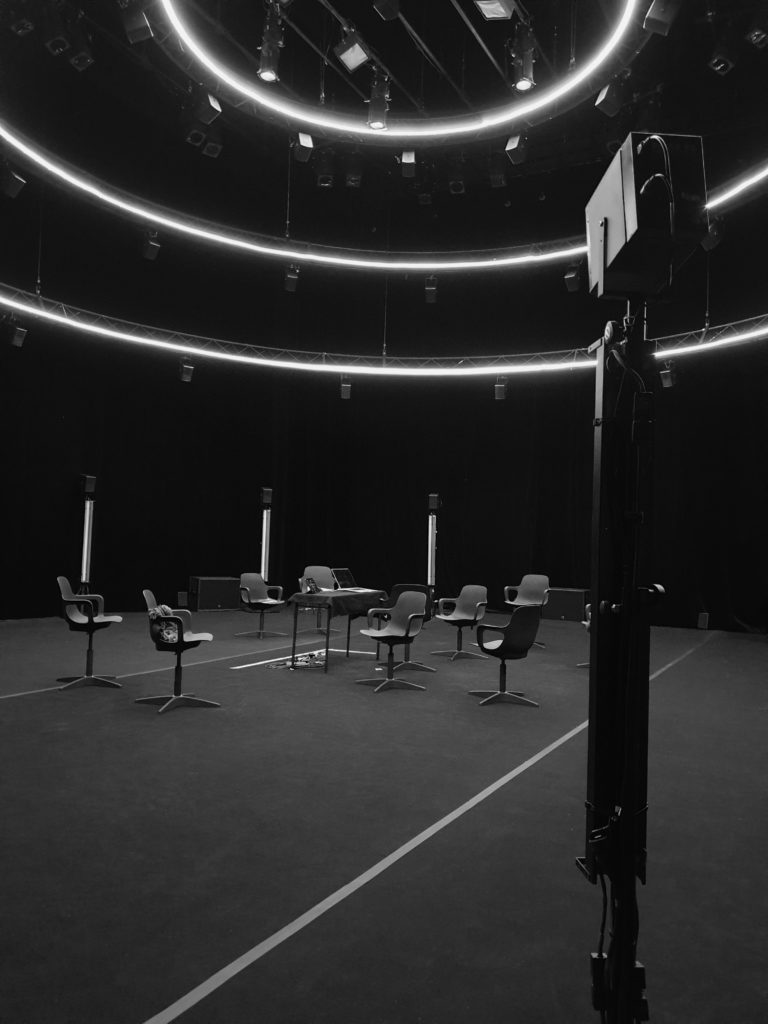
bacchantes tests at t2g gennevilliers, france _nov 2020
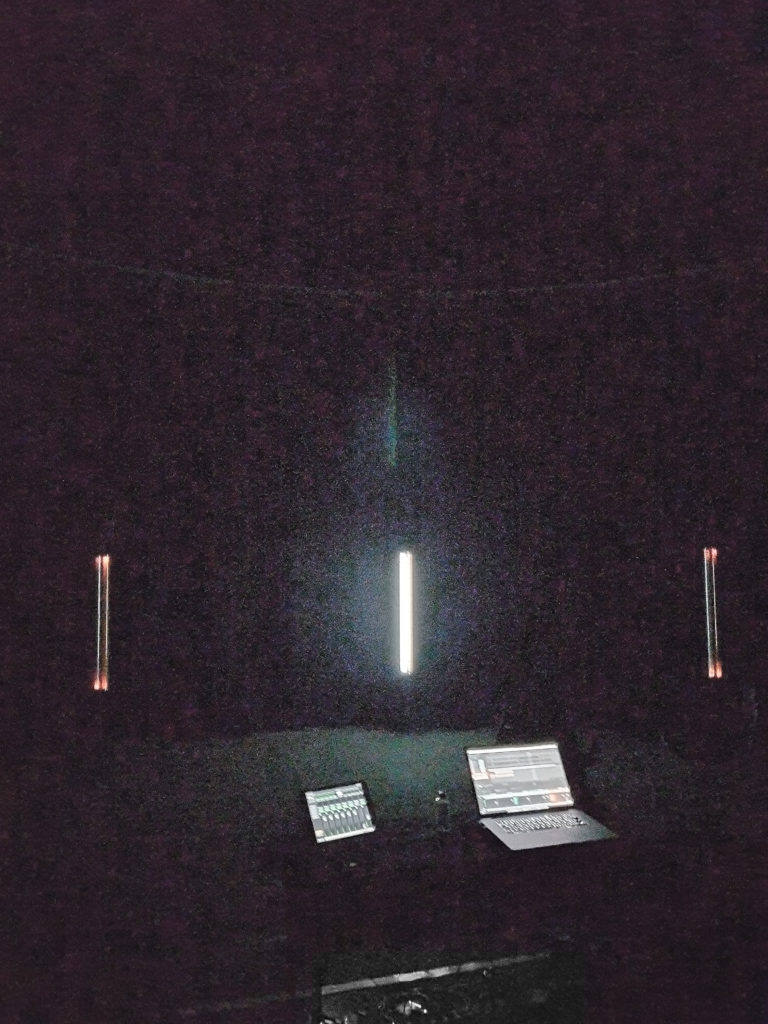
bacchantes tests at t2g gennevilliers, france _nov 2020 (448-channel reaper session for the ones who want to know)